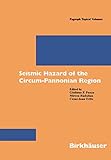Seismic hazard of the circum-pannonian region Libro electrónico edited by Giuliano F. Panza, Mircea Radulian, Cezar-Ioan Trifu
Tipo de material: Libro
en línea Idioma: Inglés Series Detalles de publicación: Boston, Massachusetts, United States Birkhauser Verlag c2000Descripción: vi, 279 páginas ilustraciones mapas 25 centímetrosISBN:
Libro
en línea Idioma: Inglés Series Detalles de publicación: Boston, Massachusetts, United States Birkhauser Verlag c2000Descripción: vi, 279 páginas ilustraciones mapas 25 centímetrosISBN: - 3764362634
- 0817662634
- 9783764362638 (Print)
- 9783034884150 (Online)
- Disponible en línea
Incluye bibliografía
1. Introduction.. 2. Construction of a seismotectonic model: the case of Italy.. 3. The seismotectonic characteristics of Slovenia.. 4. Characterization of seismogenic zones of Romania.. 5. Identification of future earthquake sources in the carpatho-balkan orogenic belt using morphostructural criteria.. 6. Modelling of block structure dynamics for the vrancea region: source mechanisms of the synthetic earthquakes.. 7. Stress in the descending relic slab beneath the vrancea region, Romania.. 8. Upper crustal velocity structure in Slovenia from Rayleigh wave dispersion.. 9. Generalised seismic hazard maps for the pannonian basin using probabilistic methods.. 10. Seismic zoning of Slovenia based on deterministic hazard computations.. 11. A contribution to seismic hazard assessment in Croatia from deterministic modeling.. 12. Synthetic seismogram based deterministic seismic zoning for the Hungarian part of the pannonian basin.. 13. Seismic hazard of Romania: deterministic approach.. 14. Estimation of site effects in bucharest caused by the may 30-31, 1990, vrancea seismic events.. 15. The dependence of Q with seismic-induced strains and frequencies for surface layers from resonant columns.. Bibliography
Disponible para usuarios de ECOSUR con su clave de acceso
Requiring the adaptation of probabilistic maps to design ground motions; and (d) the generalization of design parameters to locations where there is little seismic history. Maximum displacements, velocities, and, based on the European Build ing Code EC8, design ground acceleration maps have thus been produced by ZivCic et al. for Slovenia, Marku§ic et al. for Croatia, Bus et al. for Hungary, and Radulian et al. for Romania. The last two contributions in the volume are dedicated to studies of local site effects that could affect the microzonation of large urban areas. Moldoveanu et al. employed a technique based on the modal summation and finite dif ferences to calculate the expected ground motion in the capital city of Bucha rest due to large intermediate-depth Vrancea earthquakes. Their results outline that the presence of alluvial sediments and the possible variation of event scenario require the use of all three components of motion for a reliable determination of the seismic input. The study of Marmureanu et al. , more limited in scope, offers a laboratory analysis of the attenuation effects for sur face layers. The authors confirm that seismic attenuation in sedimentary layers is a function of the strain levels induced by large earthquakes, and find that the quality factor is nearly constant over a relatively wide frequency range, between 7 and 100 Hz. Inglés
Disponible en línea
Disponible en formato PDF


